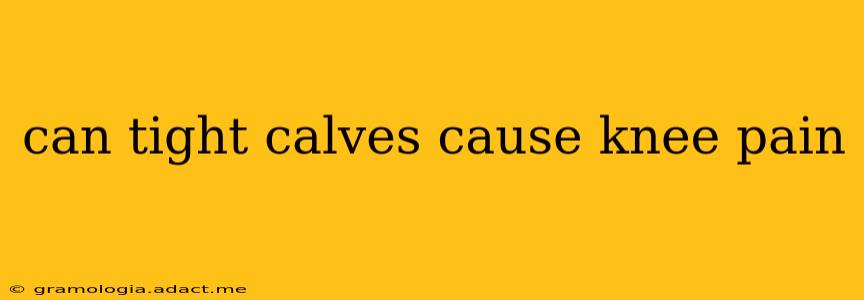Tight calf muscles can absolutely contribute to knee pain, often in ways that aren't immediately obvious. While the pain might seem to originate in the knee, the root cause could lie in the interconnectedness of your lower leg and knee joint. This article will explore this relationship in detail, addressing common questions and offering potential solutions.
How Tight Calves Impact Knee Alignment
Your calf muscles, specifically the gastrocnemius and soleus, play a crucial role in ankle and knee function. Tight calves can lead to:
-
Altered Ankle Mobility: Restricted ankle dorsiflexion (the ability to pull your toes towards your shin) can force your knee inward during activities like walking, running, or even standing. This inward movement, known as knee valgus, puts stress on the ligaments and cartilage of your knee, increasing your risk of pain and injury.
-
Increased Strain on Knee Joint: When your ankle's range of motion is limited, your knee compensates by working harder. This increased strain can lead to pain, inflammation, and potentially more serious conditions like patellofemoral pain syndrome (runner's knee).
-
Muscle Imbalances: Tight calves often exist alongside weak hip and core muscles. This imbalance further disrupts proper movement patterns, placing additional stress on your knee joint.
What are the Symptoms of Knee Pain Related to Tight Calves?
The symptoms can vary depending on the severity of the tightness and the individual. Common symptoms include:
-
Pain behind or around the kneecap: This is a hallmark of patellofemoral pain syndrome, often associated with tight calves and poor knee tracking.
-
Pain on the inside or outside of the knee: This can indicate ligament strain resulting from abnormal knee alignment caused by calf tightness.
-
Stiffness in the knee: Difficulty bending or straightening your knee can be a sign of underlying muscle imbalances and restricted movement.
-
Swelling in the knee: Inflammation can occur as a result of the increased stress and strain on the joint.
Can Tight Calves Cause Knee Pain Only?
No, tight calves are rarely the sole cause of knee pain. Other factors can contribute, including:
- Previous Knee Injuries: Prior injuries can predispose the knee to further pain and dysfunction, even if the calf tightness is a contributing factor.
- Arthritis: Degenerative joint disease can cause knee pain independent of calf tightness, although muscle imbalances can exacerbate the problem.
- Meniscus Tears: Damage to the cartilage in the knee can result in pain, sometimes worsened by poor biomechanics caused by tight calves.
- Other Muscle Imbalances: Weakness in the hip and core muscles can further contribute to poor knee alignment and pain.
How to Diagnose Knee Pain Related to Tight Calves?
A thorough physical examination by a doctor or physical therapist is essential for diagnosis. They will assess your range of motion, muscle strength, and overall movement patterns. Imaging techniques, such as X-rays or MRI scans, may be necessary to rule out other underlying conditions.
How to Treat Knee Pain Caused by Tight Calves?
Treatment focuses on addressing both the calf tightness and any underlying muscle imbalances. This typically involves:
-
Stretching: Regular calf stretches are crucial to improve flexibility and restore normal ankle mobility. Focus on both gastrocnemius and soleus stretches.
-
Strengthening Exercises: Strengthening exercises for the hip and core muscles help improve stability and reduce strain on the knee joint.
-
Physical Therapy: A physical therapist can guide you through a personalized exercise program and provide manual therapy techniques to improve joint mobility and muscle function.
-
Proper Footwear: Wearing supportive shoes with good cushioning can help absorb shock and reduce stress on the knees.
How Can I Prevent Knee Pain Related to Tight Calves?
Prevention involves maintaining good flexibility, strength, and overall fitness. This includes:
- Regular Stretching: Incorporate calf stretches into your daily routine.
- Strength Training: Focus on strengthening your hip and core muscles.
- Proper Warm-up: Always warm up before any physical activity to prepare your muscles for exercise.
- Maintaining a Healthy Weight: Excess weight puts additional stress on your joints.
By addressing calf tightness and other contributing factors, you can significantly reduce your risk of knee pain and improve overall lower extremity function. Remember to consult with a healthcare professional for a proper diagnosis and personalized treatment plan.
